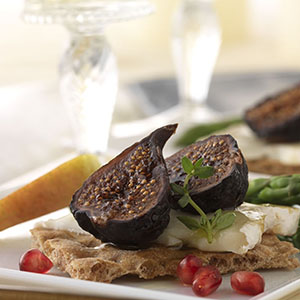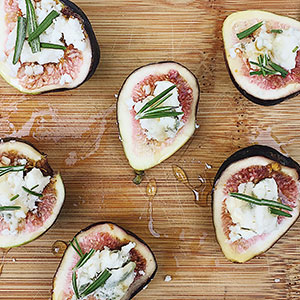Some would say that biting into a sweet, sticky, squishy fig has been a gastronomic pleasure since the beginning of time. Fig trees purportedly shaded Adam and Eve and provided them with their first hint of clothing. Archaeologists have found fig branches next to human remains that date from more than 7,000 years ago. Some scientists believe the fruit trees may have been among the first domesticated crops.
In the summer, fresh figs can be beautifully paired with a variety of hard and soft cheeses. When the holidays come around, many people incorporate dried figs into traditional baked goods or succulent holiday dishes and serve them with rich dairy delights. The combinations are bountiful and a great way to impress family and friends.
Figs originated in western Asia and spread throughout the Mediterranean region in ancient times. Today, they can be found on nearly every continent. They grow best in hot, dry places, such as California, which is the number one fig-producing state in America. However, they can be cultivated in cooler places, especially temperate areas with a nearby ocean. The United States ranks sixth in world fig production behind Egypt, Turkey, Algeria, Morocco and Iran.

A Fig Education
The two most common fig varieties are Black Mission and Brown Turkey. The latter has a purple-black skin and super sweet flavor. The former is known for its purplish-brown or bronze-colored skin and milder flavor.
If you visit farmers markets in the summer, you may have noticed baskets full of green or yellowish figs. Among the popular varieties of the pale yellow Calimyrna, which are often used in processed foods, such as Fig Newtons, are amber-skinned Kadota and light green Sierra. The dramatic-looking Panaché or Tiger has yellow skin with green stripes and an interior that’s a bright red-purple shade. Notes of berry and citrus are present in this attractive delicacy.
It’s tempting to think of all figs as tasting the same, but their flavor is as varied as the color of their edible skin. “There’s kind of a correlation I draw between figs and wine,” says Kevin Herman, owner of The Specialty Crop Co., a California farm that grows figs, nuts, pomegranates and persimmons. “You don’t just think of wine. Chardonnay is buttery. Zinfandel is jammy. Some of the same adjectives could apply to different fig varieties. Some are higher in acid and some are creamier.”
Next summer, invite friends over and do a taste test to compare nuances in the flavors and textures of different figs. It’s hard to imagine a better way to spend a warm evening – especially if you have some good cheese and wine on hand.
“One of the unusual things about figs is that there’s two very distinct and separate crops,” says Herman. “When the fig trees leaf out in the springtime, the leaves come out, but there are also some figs that come out on last year’s growth. That crop typically gets ripe in the middle of June and lasts until early July. Then there’s a fall crop that comes out on the current year’s growth.”
Even within the summer and fall crops, not all of the fruit is ready at once, says Herman. “They ripen in stages, so when we’re harvesting for fresh or dried figs, we have to go out there multiple times so we make sure we only harvest the ones that are ready.” Unlike apples, bananas and many other fruit varieties, figs will not continue to ripen once they’re picked.
Another interesting fact about figs is that, unlike most fruit trees, they don’t flower. The figs grow from tiny knobs that appear on the branches. These growths were described by Jennifer Schultz Nelson, a researcher at the University of Illinois Extension Service, as “a flower turned inside-out.” Most of these juvenile fruits still need pollination, though. That is typically done by species of wasps that have co-evolved with the trees over time.
The fruit of a fig tree isn’t the only part that you can cook with. In recent years, it’s been popular to wrap salmon in fig leaves and bake it. The leaves impart hints of coconut and vanilla. Goat cheese can also be wrapped in fig leaves and aged to give it similar flavor notes. In her book Dandelion and Quince, author Michelle McKenzie talks about smoking and drying fig leaves, then grinding them up for use in cookies and panna cotta.

In addition to tasting great, figs are healthy. “Per unit of measure, figs have more potassium than a banana, more fiber than prunes and more calcium than milk,” says Herman. That’s one more reason you can feel good about serving them.
The domestic fresh fig season runs from June to September. Imported figs are typically available from December to April, but they tend to be more expensive. When the trees have gone dormant, dried figs are readily available at grocery stores and specialty suppliers. That means the classic pairing of figs and cheese can be enjoyed throughout the year.
My favorite fresh fig and cheese pairing starts with another delectable ingredient: bacon. Chop it up and sauté it with sliced onions until the onions have caramelized. Season the mixture with pepper, then add some quartered figs and fresh rosemary. Continue cooking until the figs are very soft. Pour the blend over a block of fresh goat cheese and serve it with fresh bread.
Herman’s wife, who he describes as a great cook, likes to slice partway through a fig so the sides open up like flower petals. She stuffs honey-sweetened Mascarpone in the center and tops it with toasted pine nuts, cinnamon and Amaretto. Another favorite recipe is to fill a fig with goat cheese, then wrap it in bacon or pancetta and grill it. Each sweet-savory bite can be drizzled with a balsamic vinegar reduction.
Janet Fletcher, author of three books on cheese and publisher of the blog Planet Cheese, has several other suggestions. “I think figs are appropriate for all kinds of cheese, but in my mind they have a special affinity with unripened Chevré and Blue cheeses,” she says. “That sweetness seems to mellow the piquancy of Blues.
“If you have fresh figs with aged Gouda, you have a dessert all in itself,” continues Fletcher. “The fruit pairs well with the cheese’s caramel and butterscotch notes.” Another good dessert option is figs with Ricotta and a little local honey. Or find an almond-packed Spanish fig cake and present it with slices of salty Manchego or Parmigiano Reggiano.
Serving dried figs can be as simple as scattering them around a before- or after-dinner cheese platter. Adding in-shell walnuts, toasted almonds or hazelnuts will give the plate more of that special holiday feel.
If you’d rather eat them with a meal, add dried figs to a tossed salad along with Blue cheese crumbles or shavings of Ricotta Salata. They’re a nice contrast to the gentle bitterness of frisee or pepperiness of arugula. “You can always plump dried figs in a little bit of brandy or water to soften them up,” says Fletcher. “Since figs are quite sweet, you don’t need a sweet dressing. I would avoid something like a balsamic dressing because the figs are already sweet enough.”
Pasta with California Dried Fig Sofrito & Parmesan
By Chef Robert Del Grande, Restaurant RDG & Bar Annie, Houston

Serves: 4
Ingredients:
1 pound dried spaghetti or other pasta
3 quarts water
1 tablespoon salt
Fig Sofrito
2 tablespoon butter
4 ounces dried Mission Figs: minced
4 cloves garlic: minced
1/4 white onion: minced
2 fillets anchovy: mashed or minced (optional)
1/4 teaspoon fennel seed
1 teaspoon black pepper: freshly ground
1/4 cup fresh basil or Italian parsley: chopped
4 tablespoons butter
1 cup parmesan cheese: grated
Garnish
red chili flakes
additional grated parmesan
Combine the water & salt in a large pot and bring to a boil. Add the pasta and cook until just tender — about 10 minutes. For the Fig Sofrito, melt the butter in a skillet. Add the minced figs, garlic, onion, anchovy fillets (optional), fennel seed and black pepper and sauté until the onions are lightly cooked. Add the basil or Italian parsley, briefly stir and then remove the skillet from the heat. When the pasta is almost cooked, remove ½ cup of the water from the pot and add it to the skillet with the fig sofrito. Return the skillet to the heat and bring the water to a simmer. Add the butter. Drain the pasta. (Do not over drain the pasta – some water should still cling to the pasta.) Immediately transfer the pasta to a bowl. Add the warm fig sofrito and the grated parmesan cheese to the bowl. Toss the pasta to coat. Serve immediately. Garnish with red chile flakes and additional grated parmesan cheese.



